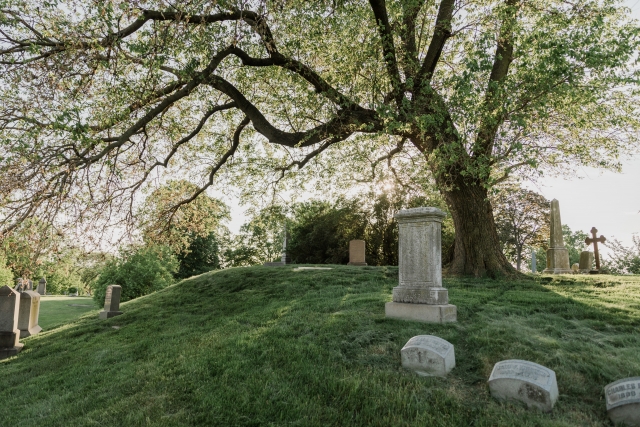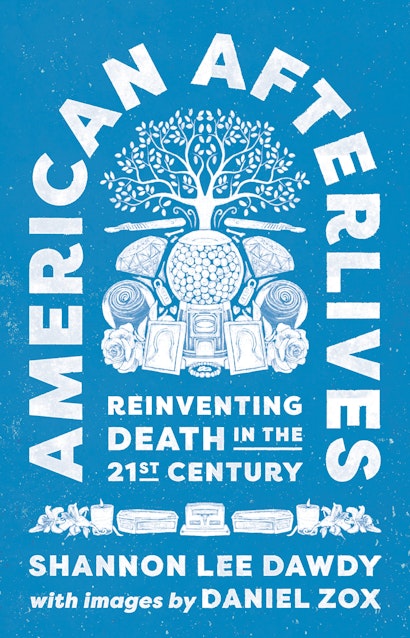Death in the United States is undergoing a quiet revolution. You can have your body frozen, dissected, composted, dissolved, or tanned. Your family can incorporate your remains into jewelry, shotgun shells, paperweights, and artwork. Cremations have more than doubled, and DIY home funerals and green burials are on the rise. American Afterlives is Shannon Lee Dawdy’s lyrical and compassionate account of changing death practices in America as people face their own mortality and search for a different kind of afterlife.
I asked my diverse Facebook friends what they might like to know about my book prior to reading it. Below is a selection of their questions, lightly edited. I’m so grateful for their thoughtful prompts!
Drew (Illinois): Do you think and feel differently about death and spirituality now than before writing this book?
I do! The whole journey I’ve taken through the American deathscape has brought me a surprising amount of peace. I even look at trees differently now, as the reader will discover.
Warren (Oregon): How has the rise of “spirituality,” increased diversity of religious practices, growing atheism, etc., affected death practices?
I actually started the project asking myself “what does the afterlife look like in an increasingly secular society?” But through my conversations with Americans from all walks of life, I came to realize that this question was wrong-headed. It’s not that Americans are becoming more secular, it is that they are becoming more spiritual. But in so many different, self-directed ways, it is difficult to grasp with conventional social science. This is the cult of the individual turning into thousands of individual cults…
Micaela (Illinois): How did your personal experience of loss bring you to this project?
In some ways, this project has roots in my experience as a volunteer surveying the devastation wrought by Hurricane Katrina in 2005. I think it imprinted me with the impermanence of human worlds. Then, between 2008 and 2013, I lost my father, my niece, and two close friends. In that period, I visited my first funeral home and I learned about the creative options one has now to handle human remains and to invent your own rituals. Through my trauma daze, I became intrigued. Research is for me a way to emotionally process things. Not by getting cold and analytical about it but by digging for information and talking to people who have had similar experiences in order to gain some perspective on my pain. It’s only then that I can start to heal. So the project flowed pretty naturally from my personal life. Put another way, I only became fascinated by death culture when I was plunged into it. I was never a goth girl.
Lori (London, UK): How bad for the environment IS cremation? My partner wants to let dogs eat him; is that possible? Or to get tossed over the side of a boat. Can we do that?
I love these kinds of questions—and the fact that they are so ask-able these days. Rather than respond directly, I’m just going to say that if you’re a reader with this type of curiosity, I do discuss the moral economy of different corpse treatments, and describe some options that you have probably never considered. I’m also confident that the list of post-death possibilities is going to keep growing in the twenty-first century. The United States is the country where you are most likely to be able to have death “your way,” so your partner may have to head this way to access the full menu.
Roy (Washington, D.C.): What does an anthropologist or an archaeologist have to offer on this subject that journalists and others don’t? And what is an anthropologist doing studying the US?
At its root, anthropology is about how groups think, and about documenting the diversity of those thoughts. Without taking into account the cultural forces that anthropologists are specially trained to detect, you will be at a loss to explain much of human behavior. The discipline’s early ties to European colonialism used to mean a focus on “non-Western Others,” but in the last 30 years the field has matured and anthropologists are just as likely to focus on social worlds close to home, wherever that may be. It’s more about methods and a philosophy. With the archive we have built up about cultures all over the world, anthropologists are also those best equipped to put American culture in comparative perspective. When it comes to human remains and the ritual objects associated with them, archaeologists are even better positioned. One of the mainstays of our specialty is to try to understand societies through their mortuary practices. I just happen to be doing this with a living society. One of the questions that interests me in the book is: just how weird is American death culture?
Heath (Athens, Greece): What was the most surprising or disturbing thing you came across?
There were many moments when I experienced a sense of the uncanny, or a profound dis-ease. Trying to understand my reactions in those moments led to some of the biggest breakthroughs in the writing. If I had to pick just one, I guess it would be encountering former President Obama’s disembodied head. And that’s as much a spoiler as I’ll allow…
Christina (California): I’m curious, how do you define who/what is “American”?
As far as I’m concerned, anyone is American if they live within the current political territory of the United States. I prioritized innovators and death care professionals who could help us understand what is happening at the vanguard of death practices rather than targeting demographics. But Daniel Zox and I did film a number of person-on-the-street interviews, constituting a type of random sample of Americans. We asked them: “what do you want done with your body?” and “what do you think happens to us after we die?” While I can’t claim that this cross-section of strangers was representative of such a large and diverse country (that would require statistical methods at odds with my intimate ethnographic approach), I did find that an openness to cross-cultural influence is one of the defining features of our current moment. Change, not tradition, rules the day.
Kristina (North Carolina): Does your book address Mitford’s American Way of Death at all? That book was super popular in the 1960s—what has and hasn’t changed since that book?
Thank you for bringing up the most important precursor to American Afterlives—and one that I hope it supersedes! Even if they have never heard of it, most Americans have been influenced by Mitford’s critique of the mid-century funeral industry, with its costly once-size-fits-all package of embalming, viewing, and vault burial. She insisted that the right way to do death was cheap, direct cremation without a fussy ceremony. After Mitford, the U.S. cremation rate grew, but relatively slowly—until the events of 9/11, a correlation I explore in the book. If she were alive today, Mitford might be annoyed to learn that cremation has facilitated a vast new range of memorial commodities and ritual “fuss” that Americans have enthusiastically embraced. She also didn’t anticipate the rapid growth of green burials. These developments suggest that she may have over-emphasized machinations by the funeral industry and under-estimated the power of ritual practice. So I backtrack to questions that she blew past: Why were Americans so big into viewing the embalmed corpse? What did it do for them?
Lee (California): After seeing so many images of Covid-related container morgues lined up outside of hospitals, have people’s seemingly elaborate plans for death and post-death been altered?
As I was working on the manuscript throughout 2020 and the early part of 2021, I followed up with several of my interviewees to ask them how they were doing and what changes they were seeing. Business was sadly brisk, though also impacted by temporary bans on large gatherings. Most of the patterns I discuss have only accelerated under Covid. One new factor: several people noted an uptick in “pre-planning” by new and younger clients. As I explain in the book, I disagree with the common argument that Americans are supreme “death deniers” (it’s more complicated—and more interesting—than that), but it is also true that the pandemic has triggered a collective existential crisis, forcing us to confront the reality of our eventual expiration dates.
Cheryl (New Mexico): How are the new practices around death changing the outlook of survivors? As the old rituals are changed or abandoned, how has the mourning process changed?
I find it fascinating that people are finding ways to keep the dead socially alive in ways that haven’t been acceptable since the Victorian era. It’s becoming OK (once again) to include them in our daily lives—to talk to them, to honor their birthdays and deathdays, to keep their remains close. And not just in our private lives. After going through a long period in the twentieth century when public mourning was uncomfortable, even taboo, it is now becoming acceptable again, particularly via social media and street shrines. There’s even mourning clothes in the form of commemorative t-shirts. So one of my arguments is that “re-inventing” death in part involves reviving it—bringing back pre-industrial ways of doing things, such as home funerals and green burials, which used to simply be the norm.
Barbara (Virginia): What do you think is driving this revolution in death practices?
That is THE question. Unfortunately, I can’t think of an answer that is less than about 272 pages long!
Shannon Lee Dawdy is an anthropologist, archaeologist, and filmmaker. A professor at the University of Chicago and a MacArthur Fellow, she is the author of Patina: A Profane Archaeology and Building the Devil’s Empire: French Colonial New Orleans. Film website ilikedirtfilm.com

